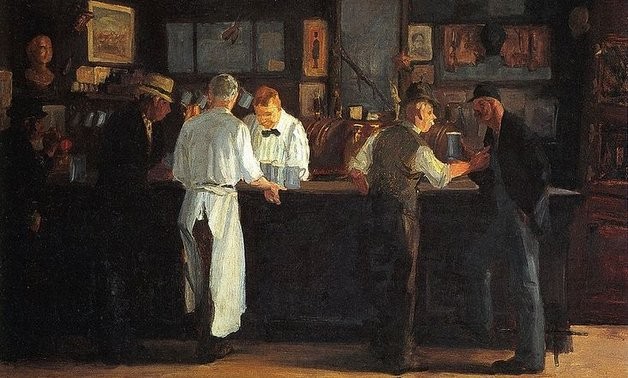Millions of tourists come to New York each year, many of them hoping to see such landmarks as the Statue of Liberty, the Empire State Building, and Ellis Island. And as famous and iconic as these destinations are, there are some tourists (and many locals) who insist on crowning any trip to “the City” with a visit to a still more ancient institution: a bar. McSorley’s Alehouse has been open since 1854 (for those keeping track, that’s 38 years before Ellis Island opened, 32 years before the Statue of Liberty was dedicated, and 75 years before the Empire State Building was even started).
Better understood, McSorley’s isn’t a bar. That’s because a bar usually avails itself of modern conveniences, like music equipment, a full liquor shelf, and a set of glasses to complement every sort of drink that a patron might order. The only noise in McSorley’s comes from the conversations people share, not canned music. Liquor was offered ad experimentum for a few years—in the first decade of the 20th century. Since that experiment failed, McSorley’s has been an alehouse. The only alcohol available is the two drinks on offer: ales termed the “Light” and the “Dark.” The only glass available is an 8 oz mug, usually brought out two by two. Nothing has been removed from the walls in decades, and hanging from the chandelier are turkey bones that have rested there since the First World War. Ellis Island became a museum. The Statue of Liberty was renovated for its centenary. Even the Empire State Building has been retrofitted for the needs of today’s tenants.
But McSorley’s remains just as it was. There, as Ecclesiastes proclaims, “There is nothing new under the sun.”
And yet, there are a few rare occasions that bring change to this institution. Christmas time brings decorations. The anniversary of the alehouse brings out a corps of Revolutionary War reenactors, dubbed the McSorley’s Militia. And, being an Irish Establishment, they mark St. Patrick’s Day with its own reverence. Whence comes the change? What novelty can interrupt 150 years of tradition?
Our Lord promises that He will make all things new, and He does so in fulfillment of Psalm 98. There, the psalmist enjoins us to sing “a new song” to the Lord (Ps. 98). In his commentary on this verse, St. Augustine explains that it is the new man (put on in baptism) who knows this, not the old man (born in sin).
St. Patrick could certainly understand this injunction. Having been brought to Ireland in slavery, his response was a novel one. Escaping the bondage of slavery, his newfound freedom was not one of autonomy and self-fulfillment. Instead, he recognized in his baptism the charge to spread the Gospel, that he might free from servitude to sin those who had held him captive.
Looking on fifteen centuries later, this novelty looks instead to be cliché. However, that would not be how St. Patrick saw it, or his apostolic forebears. When St. Paul was held bound in prison, an earthquake providentially shook the fetters and bars apart. Rather than escape, Apostolic witness demanded a more creative response:
When the jailer woke and saw that the prison doors were open, he drew his sword and was about to kill himself, supposing that the prisoners had escaped. But Paul cried with a loud voice, “Do not harm yourself, for we are all here.” And he called for lights and rushed in, and trembling with fear he fell down before Paul and Silas, and brought them out and said, “Men, what must I do to be saved?” (Acts 16:27-30)
The jailer, having been shocked out of his expectations, could receive the Gospel on its own terms. St. Patrick is better remembered not for being a bearded old man like Santa Claus, but for bringing something very young and vibrant to the Emerald Isle. Through his ministry, the entire nation was able to be reborn in baptism. This new life, started by the inspiration of one saint, has grown a hundred-fold: the sons of St. Patrick have been sent off as missionaries from the sixth century through the twentieth century.
The psalmist enjoined his “new song” to resound “from the ends of the earth.” Freed from every sort of slavery and made anew by Christ, St. Patrick, in apostolic zeal, was able to ultimately effect just that. While his legacy is reflected in such marvelous ways, there are humbler echoes of this new song, like the bustle within an ancient New York watering hole and the green tinge of a shamrock shake.
✠
Image: John Sloan, McSorley’s Bar







